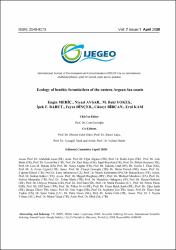| dc.contributor.author | Meriç, Engin | |
| dc.contributor.author | Avşar, Niyazi | |
| dc.contributor.author | Yokeş, M. Baki | |
| dc.contributor.author | Barut, İpek F. | |
| dc.contributor.author | Dinçer, Feyza | |
| dc.contributor.author | Bircan, Cüneyt | |
| dc.contributor.author | Kam, Erol | |
| dc.date.accessioned | 2021-11-15T07:19:31Z | |
| dc.date.available | 2021-11-15T07:19:31Z | |
| dc.date.issued | 2020 | en_US |
| dc.identifier.issn | 2148-9173 | |
| dc.identifier.uri | https://hdl.handle.net/20.500.12462/11704 | |
| dc.description | Bircan, Cüneyt (Balikesir Author) | en_US |
| dc.description.abstract | The aim of this study was to determine the distribution of benthic foraminifera in some field of the Turkish Aegean coasts have been
investigated and the effects of ecological changes observed on these fauna in 2009-2014 period. Sediment samples from Alibey and
Maden Islands (Balıkesir), Kuşadası (Aydın), Çeşme Ilıca Bay (Izmir) and northwestern coast of Karaburun Peninsula (Izmir) have
been analysed. Similarities, as well as dissimilarities were observed between the assemblages from different locations. The Red Sea
orginated alien foraminifer Amphistegina lobifera Larsen was found to form a very dense population around the south and west part
of a submarine spring water in Kuşadası, where as it was replaced by Ammonia compacta Cushman and Elphidium crispum (Linné)
assemblages on the northern and eastern parts. Euthymonacha polita (Chapman) has been first recorded in Kuşadası and it is also
abundant in the Ilıca Bay. The Red Sea originated Coscinospira acicularis (Batsch) has also been first recorded in the Mediterranean
from Ilıca Bay. Presence of the individuals with colored tests indicates the presence of heavy metals in spring waters. Aberrant aperture
morphologies observed in some of the Vertebralina striata d’Orbigny individuals attracts attention. Therefore, abundance of individuals
with colored tests, morphological deformities or togetherness, as well as the Red Sea originated species have indicated the special
environmental and ecological conditions around the submarine springs. The main reasons for these ecological changes are salinity
changes, the presence of heavy metals, thermal springs and cold-water springs. It is noteworthy that there is a different benthic
foraminiferal living due to physical and chemical changes in the regions where different ecological conditions develop around the
submarine thermal / cold water springs observed in these coastal regions. | en_US |
| dc.language.iso | eng | en_US |
| dc.publisher | Cem Gazioğlu | en_US |
| dc.rights | info:eu-repo/semantics/openAccess | en_US |
| dc.subject | Alibey and Maden Islands (Ayvalık, W-TR coasts) | en_US |
| dc.subject | Benthic Foraminifer | en_US |
| dc.subject | Ecological Factors | en_US |
| dc.subject | Ilıca Bay | en_US |
| dc.subject | Karaburun Peninsula | en_US |
| dc.subject | Gulf of Kuşadası | en_US |
| dc.title | Ecology of benthic foraminifera of the eastern Aegean Sea coasts | en_US |
| dc.type | article | en_US |
| dc.relation.journal | International Journal of Environment and Geoinformatics | en_US |
| dc.contributor.department | Mühendislik Fakültesi | en_US |
| dc.contributor.authorID | 0000-0002-4399-8961 | en_US |
| dc.identifier.volume | 7 | en_US |
| dc.identifier.issue | 1 | en_US |
| dc.identifier.startpage | 6 | en_US |
| dc.identifier.endpage | 22 | en_US |
| dc.relation.publicationcategory | Makale - Ulusal Hakemli Dergi - Kurum Öğretim Elemanı | en_US |


















